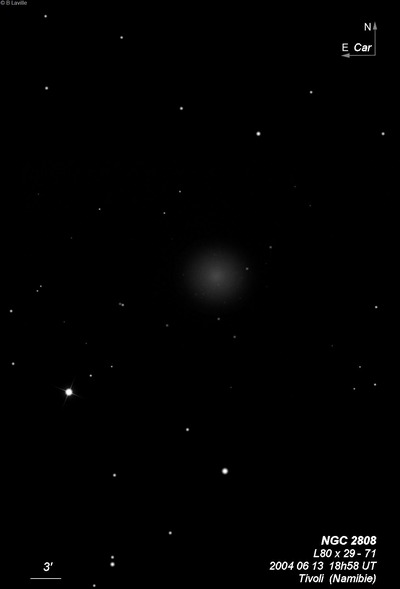
James Dunlop discovered NGC 2808 = D265 = h3152on 7 May 1826 and recorded "a very bright round nebula, about 3' or 4' diameter, very gradually bright to the centre. This has a fine globular appearance." His position is 20' too far northwest, but the identity is certain.
John Herschel recorded 4 detailed observations from the Cape of Good Hope: On the first sweep (8 Mar 1834) he logged it as a "globular cluster, extremely compressed pretty gradually very much brighter to the middle; up to a perfect blaze; diam. in RA = 26.8 seconds; stars of 16th magnitude." His final observation (9 Feb 1837) notes "a truly beautiful and delicate globular cluster; diameter in RA = 45 seconds, that of the most compressed part 15 seconds; gradually very bright in the middle; all finely resolved into perfectly equal stars like the finest dust, which are seen with the left eye without effort, but the right requires to be somewhat strained to discern them. Runs up to a blaze in the centre."
300/350mm - 13.1" (2/20/04 - Costa Rica): this very bright globular was large and elongated, ~8'x6' SW-NE increasing to 2' bright core and a blazing 40" nucleus. At 144x, this cluster was mottled but with no obvious resolution. At 166x a large number of extremely faint stars (mag 14-15) popped in and out of view over the entire disc, though the resolved stars could not be held steadily. Located 1.8° NNE of mag 4.0 Alpha Volantis.
10x30mm Canon IS (3/28/19 - Tasmania): fairly bright but fairly small at 10x. Contains a very bright small core. I wasn't confident of a naked-eye sighting.
400/500mm - 18" (7/8/02 - Magellan Observatory, Australia): at 171x, this bright globular (ranked 10th brightest at V = 6.1) is fairly large, ~10' diameter and very compressed with a blazing 2' core. The halo is noticeably elongated, nearly 3:2. A dense swarm of mag 14 and fainter stars were resolved in the halo and around the edges of the core but the inner central core was unresolved. At 228x, there appeared to be some very faint stars lanes streaming into the halo, which were barely unresolved but looked like small tentacles. A mag 10/10.6 double at 16" is outside the cluster ~10' ESE. This is by far the brightest concentration class I globular and the only one easily resolved.
600/800mm - 24" (4/11/08 - Magellan Observatory, Australia): at 200x, this was a stunning showpiece globular in the 24"! The central region displayed an unusually strong concentration with a super-intense 2' core that was unresolved. A very bright, small halo surrounded the core, which was mottled but mostly unresolved. The outer halo resolved into perhaps 150-200 mag 14.5 and fainter stars. The halo gradually thinned out in resolved stars out to 10' diameter. The core was smaller but still unresolved at 350x. The overall appearance of the three brightness levels mentioned above is unusually symmetrical.
Naked-eye - (7/8/02 - Magellan Observatory, Australia): faintly visible naked-eye.
Notes by Steve Gottlieb